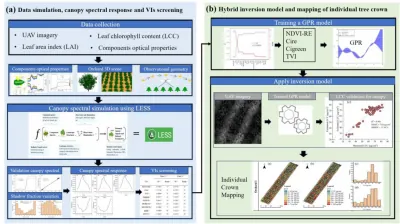
Revolutionary UAV Imaging Tackles Canopy Shadows for Precision Apple Farming!
2025-08-30
Author: Yu
The Challenge of Canopy Shadows in Agriculture
In the pursuit of optimal orchard management and smart agriculture, understanding leaf and canopy chlorophyll content is crucial. These indicators reflect photosynthetic capacity and plant health, but traditional chemical tests can be destructive and impractical on a large scale. Enter remote sensing and UAV technology—the key players in transforming how we monitor plant health.
How UAVs Are Changing the Game
While remote sensing techniques like vegetation indices (VIs) allow for non-destructive analysis, their accuracy often falters due to shadows lurking beneath dense canopies. Satellites typically neglect these shadows because of their coarse resolutions. However, drones, or UAVs, provide high-resolution imagery that exposes these inconsistencies. This scenario presents a pressing need for innovative solutions to enhance precision in chlorophyll monitoring.
A Groundbreaking Study Unveils New Methodology
A recent study led by Hao Yang's team at Beijing Forestry University, published in Plant Phenomics, has unveiled an unprecedented shadow-resistant UAV framework designed for accurate chlorophyll monitoring in apple orchards. By integrating advanced techniques such as three-dimensional radiative transfer modeling (3D RTM) with multispectral UAV imagery and Gaussian process regression (GPR), the researchers effectively tackled the cumbersome issue of canopy shadows.
Key Findings: Precision at Its Best
The study confirmed the credibility of simulated canopy reflectance against real-world measurements, revealing a parabolic pattern of shadow proportions throughout the day. Midday proved to be the perfect time for UAV data collection, as visible light reflectance peaked when shadows waned, while near-infrared reflectance took the opposite route. This critical insight guided the researchers to assess the robustness of various VIs against shadow interference.
Ranking the VIs: The New Champions!
Five indices—NDVI-RE, Cire, Cigreen, TVI, and GNDVI—stood out for their resilience against shadow variations. Among these, four indices not only excelled in shadow mitigation but also achieved impressive inversion accuracy for chlorophyll content estimations, setting a new standard for monitoring.
Applications and Impacts in Smart Orchard Management
The new model significantly enhances the ability to monitor chlorophyll content across individual trees in diverse orchards. The findings revealed substantial spatial variability, pointing to the method's effectiveness in capturing fine-scale nuances in canopy health. This shadow-resistant approach provides actionable insights without the burden of destructive sampling.
With this innovative technique, growers can pinpoint nutrient deficiencies, identify stress early, and optimize fertilizer application with unparalleled accuracy. Furthermore, mapping chlorophyll content distributions empowers farmers to implement targeted interventions, improving overall productivity, sustainability, and resourcefulness in apple farming.
Conclusion: A Bright Future for Smart Agriculture!
As the world leans into more technologically driven agricultural practices, this research represents a transformative leap forward. Imagine a future where apple orchards thrive not just through intuition and experience, but through precise, science-backed interventions that ensure every tree gets exactly what it needs for optimal growth!


 Brasil (PT)
Brasil (PT)
 Canada (EN)
Canada (EN)
 Chile (ES)
Chile (ES)
 Česko (CS)
Česko (CS)
 대한민국 (KO)
대한민국 (KO)
 España (ES)
España (ES)
 France (FR)
France (FR)
 Hong Kong (EN)
Hong Kong (EN)
 Italia (IT)
Italia (IT)
 日本 (JA)
日本 (JA)
 Magyarország (HU)
Magyarország (HU)
 Norge (NO)
Norge (NO)
 Polska (PL)
Polska (PL)
 Schweiz (DE)
Schweiz (DE)
 Singapore (EN)
Singapore (EN)
 Sverige (SV)
Sverige (SV)
 Suomi (FI)
Suomi (FI)
 Türkiye (TR)
Türkiye (TR)
 الإمارات العربية المتحدة (AR)
الإمارات العربية المتحدة (AR)